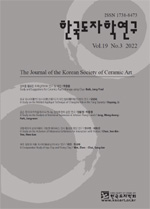중국 장사요 도자 모인첩화(模印貼花) 장식은 당나라 악주요(嶽州窯)의 음각(陰刻) 모인첩화에서 기원 하였다. 장사요(長沙窯)는 중국 당나라(唐代) 중후기에 흥성하고14),오대(五代)에 이르러 쇠퇴하였으나 장 식의 독창성과 예술성이 현대도자에 적용될 수 있는 가능성을 감지하여 본연구를 진행한다. 이 공예의 모인첩화(模印貼花) 장식은 장사요(長沙窯)의 커다란 특징 중 하나이며, 한동안 유명세를 떨쳤다. 문양 은 주로양각 모인첩화 문양이 중심이 되었고, 문양이 더욱 생동적이고 정교하며 입체적으로 표현할 수 있다. 본 연구는 당대의 장사요 모인첩화장식의 가치를 찾고 현대도자에 적용가능을 목적으로 모인첩 화 공예의 장식 문양, 공예 기법과 역사적 중요성을 소개하고, 당나라 장사요 도자 모인첩화 공예의 계승과 발전의 필요성을 논술하였다. 이를 위해모인첩화에 나타난 문양을 종류별로 설명하였고 문양제 작과정을 단계별로 제시함으로써 모인첩화 장식의 현대도자 활용에 적극적 제안을 시도하였다. 장식의 특징인 부조조각을 현대생산 기술인 3D 프린트로 대체될 수 있는 가능성을 제시함으로서 현대 도예 창작에도 전통기법의 현대화작업에 중요한 자료가 될 것으로 확신한다.
The Changsha Kiln appears in the mid-late Tang Dynasty and declines in the Five Dynasties. Its technique of molded appliqué marks a highlight of ceramic decoration art of the Tang Dynasty. It originates from the Yuezhou Kiln, which once enjoyed a reputation for molded appliqué featuring intaglio patterns. Through bold innovation, Changsha Kiln's molded appliqué patterns are mostly embossed. The vivid and exquisite patterns are more stereoscopic and the technique serves as a perspective for research. It recaps the decorative patterns, craftsmanship technique and historical significance of Changsha Kiln's molded appliqué on porcelain of the Tang Dynasty. It expounds on the importance of inheriting and developing Changsha Kiln's molded appliqué on porcelain of the Tang Dynasty. By conveying the force through the quantity, the spirit through the form, the soul through the animal image, the life through the mold, and the change through the harmony, the design style provides great inspirations for contemporary ceramic art creation.
Ⅰ. 서론
Ⅱ. 본론
Ⅲ. 결론
참고문헌
